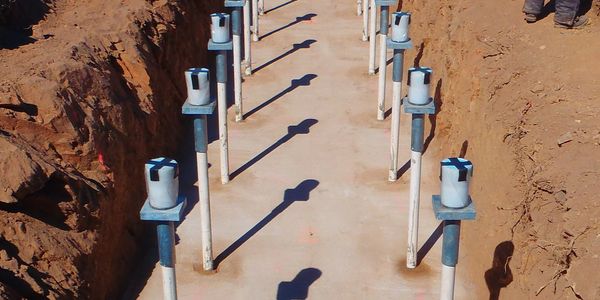Innovative Rock Anchors for Boosted Building Support
Cutting-edge rock anchors have increasingly end up being a prime focus in building and construction engineering, specifically as jobs demand better stability and performance. With improvements in products and innovation, modern anchoring options such as grouted and post-tensioned designs use significant renovations in load-bearing capacity and versatility to diverse geological problems. The integration of advanced modeling strategies even more boosts performance optimization, yet the full possibility of these developments continues to be to be explored. As we think about the effects of wise sensing units and lasting practices, one must ask: just how will these developments redefine the future of building assistance?
Evolution of Rock Anchors
The evolution of rock anchors has significantly transformed building and construction techniques over the previous century. As engineering disciplines progressed, so did the understanding of geological problems and the requirement for reputable anchoring systems.
In tandem with advancements in materials scientific research, the growth of grouting methods improved the bond in between the support and surrounding rock, leading to raised security and sturdiness. The integration of modern technology right into style and testing procedures has resulted in a lot more accurate and efficient installment techniques, further maximizing performance. Computer system modeling and simulations now enable engineers to forecast anchor actions under different problems, improving safety and dependability.
Moreover, the expanding emphasis on sustainability within building and construction practices has resulted in innovations in green materials and strategies for rock anchoring. In general, the trip of rock anchors shows the building and construction market's adjustment to both technological improvements and the increasing intricacy of modern engineering obstacles.

Sorts Of Modern Rock Anchors
Modern rock supports been available in a variety of types, each designed to satisfy specific engineering demands and geological problems. The most usual types consist of grouted anchors, which include putting a steel tendon right into a pierced hole and loading the space with grout to create a solid bond with the surrounding rock - Williams Anchors. These anchors are frequently used in applications needing high lots capacities
An additional widely utilized kind is the mechanical support, which relies upon mechanical gadgets to safeguard the anchor in location without the demand for grouting. These anchors are favored in scenarios where prompt load-bearing capacity is necessary.
Additionally, there are post-tensioned anchors, which are set up tensioned to give stability to structures such as bridges and maintaining wall surfaces. These anchors help to combat tensile pressures acting upon the framework.
Benefits of Innovative Styles
Advancement in rock support layout brings numerous advantages that improve building and construction performance and architectural integrity. Modern designs utilize advanced products and engineering strategies to substantially boost load-bearing capacities. These cutting-edge supports are often constructed from high-strength steel or composite materials, which not only reduce weight but also boost resistance to deterioration, ensuring longevity and reliability in numerous ecological problems.
Moreover, making use of computer-aided layout (CAD) and limited component evaluation (FEA) permits accurate modeling and testing of anchor efficiency under real-world problems. This leads to anchors that can be tailored to specific task needs, enhancing their efficiency and decreasing the need for over-engineering, which can be both set you back and resource-intensive.

Case Studies in Building And Construction
Real-world applications of innovative rock anchor layouts illustrate their transformative influence on construction jobs. The supports were tactically positioned to enhance tons circulation and minimize settlement, inevitably leading to an extra resilient structure.
Another substantial instance can be found in the description growth of a transport passage. Cutting-edge rock supports were used to protect the passage walls, enabling deeper excavation without endangering safety. dig this The application of grouted rock supports supplied increased tensile stamina, allowing employees to progress the project right away.
In a third situation, a significant dam task included rock anchors to stabilize the embankment. The use of corrosion-resistant products in the supports made sure lasting resilience, minimizing upkeep prices and boosting safety and security requirements.
These study show the performance of innovative rock support designs in addressing complex engineering challenges, underscoring their important role in modern construction practices. The effective results highlight the requirement for continued investment in advanced anchoring technologies to meet evolving construction needs.
Future Trends in Rock Anchoring
As building and construction needs develop, the future of rock anchoring is poised for significant advancements that will certainly boost safety and security and performance in different applications - Williams Anchors. Emerging technologies, such as clever sensing units and real-time tracking systems, are expected to play a crucial duty in the advancement of more dependable securing options. These developments will allow for continual evaluation of anchor efficiency, enabling prompt interventions and minimizing threats connected with architectural Source stability
In addition, the integration of sustainable products and techniques is ending up being significantly essential in the building and construction industry. Future rock supports might integrate eco-friendly materials that lower environmental effect while keeping performance requirements. Moreover, advancements in materials scientific research might bring about the development of high-strength, lightweight supports that simplify installation processes and minimize labor prices.

Conclusion
In final thought, ingenious rock supports stand for a substantial advancement in construction support, dealing with the difficulties presented by varied geological problems. The growth of modern designs, including grouted and post-tensioned anchors, enhances load-bearing capabilities while promoting stability. Integration of advanced technologies, such as computer-aided design and smart sensors, further optimizes performance and sustainability. Proceeded study and execution of these technologies will undoubtedly shape the future of building and construction techniques, making certain performance and ecological obligation.